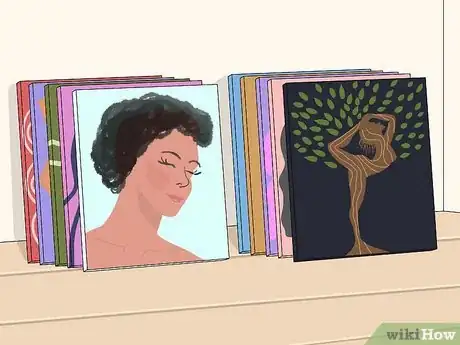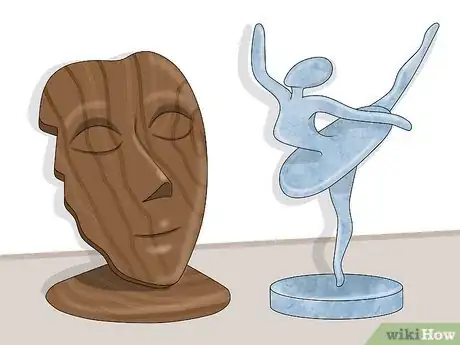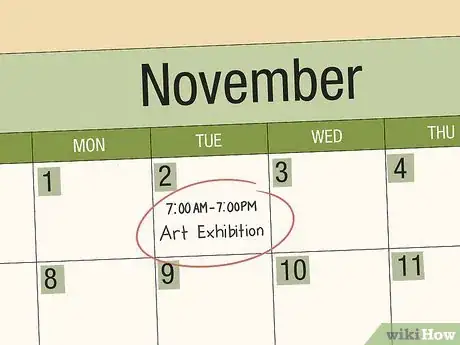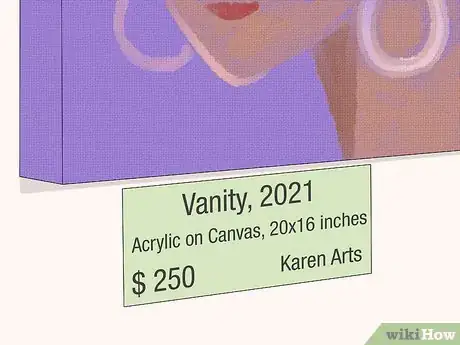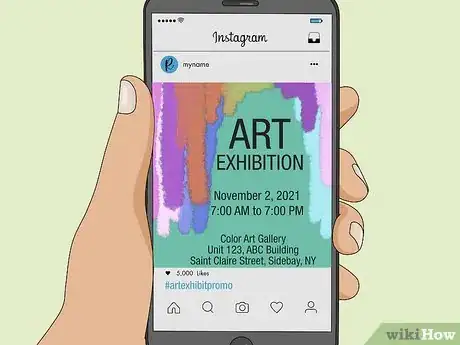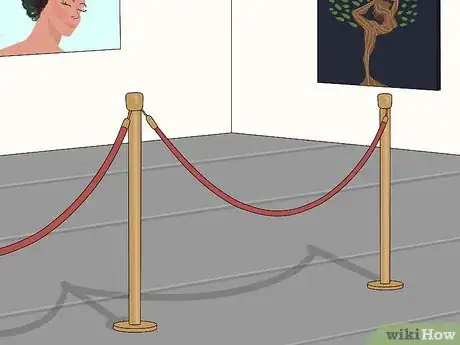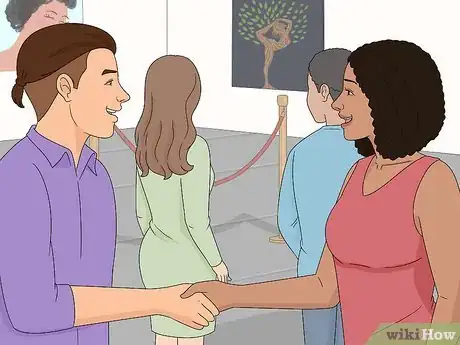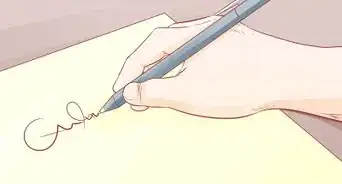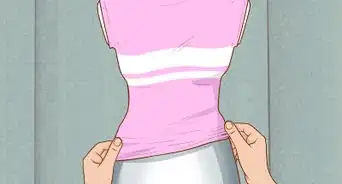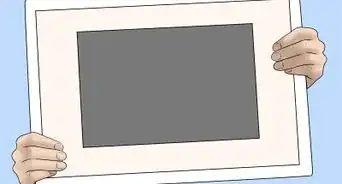This article was co-authored by Natasha Dikareva, MFA. Natasha Dikareva is a San Francisco, California based sculptor, and installation artist. With over 25 years of ceramics, sculpting, and installation experience, Natasha also teaches a ceramic sculpture workshop titled "Adventures in Clay" covering concept development, hand-building techniques, texture, and glazing techniques. Her work has been featured in solo and group exhibitions at the Beatrice Wood Center for the Arts, Abrams Claghorn Gallery, Bloomington Center for the Arts, Maria Kravetz Gallery, and the American Museum of Ceramic Art. She has taught at the University of Minnesota and the American Indian OIC School. She has been awarded the Excellence Award at the 1st World Teapot Competition, Best in Show at the 4th Clay & Glass Biennial Competition, and a Grand Prize at the American Museum of Ceramic Art. Natasha holds an MFA from the University of Minnesota and a BFA from Kiev Fine Arts College.
There are 15 references cited in this article, which can be found at the bottom of the page.
wikiHow marks an article as reader-approved once it receives enough positive feedback. This article received 18 testimonials and 83% of readers who voted found it helpful, earning it our reader-approved status.
This article has been viewed 615,805 times.
Whether you’re displaying your own work or that of other artists, holding an art exhibition is a uniquely enriching experience. However, it can be a real challenge to bring together so many different elements in a cohesive and meaningful way. That’s why when you’re staging an art exhibition of your own, it’s essential to have a plan. Once you’ve chosen a theme for your exhibition, you can begin taking submissions from interested artists, select an appropriate venue for the event and build marketing buzz that will allow your collection to be seen and appreciated by as many people as possible.
Steps
Finding Artwork to Display
-
1Choose a unifying theme. A good art exhibition should be characterized by a prominent theme that ties the different pieces together and makes them feel like part of a larger whole. Think carefully about the message you want your exhibition to convey. It could be an image or phenomenon, a feeling or a certain visual technique.[1]
- The more specific your theme, the better. For instance, “Black and White” is too general to make much of an impact, whereas “Isolation and Womanhood” explores a far more interesting pairing of ideas.
- Consider giving your exhibition a name. A catchy title like “Neon Daydreams” will help generate attention and point more clearly to the theme being presented.[2]
-
2Select your most impressive work. Pick out a few of your best or most recent pieces to put on display. If you’re holding a solo exhibit meant to highlight your own work, you’ll need to have anywhere from 10-30 individual pieces to show. The theme of the exhibition should be represented in each production.[3]
- Spend the months leading up to the exhibition creating original pieces that you can unveil for the first time on opening night.[4]
- Plan on exhibiting more pieces if the work you do tends to be on the small side.
Advertisement -
3Contact local artists for submissions. Do some research into other artists in your area and see whether they would be interested in taking part in your exhibition. Collaborative efforts can be a great opportunity for many different artists to showcase their art at the same event, resulting in a more diverse and well-rounded display.[5]
- Narrow your focus to artists who have a similar style or tend to produce works related to the theme you’re presenting.
- Holding an exhibition in conjunction with other artists will also allow you to split the cost of the venue, licensing expenses, framing and promotional materials.[6]
- Be sure to give other artists proper credit for the works they've contributed.
-
4Work with different mediums. Your exhibition doesn’t have to exclusively feature paintings or sketches. Feel free to solicit works from photographers, sculptors, and other types of visual artists. A wide-ranging selection of works will lend collaborations a dynamic atmosphere and give your patrons more to enjoy.
- In general, it’s best to stick with art you can frame, hang and sell. However, you might also consider inviting poets or musicians to perform at the event, especially if their work complements the exhibition’s theme.
Organizing the Event
-
1Set a time and date. Organizing an art exhibition requires an exhaustive amount of coordination, so be realistic about the timeframe you impose on yourself. You’ll want to start planning your event at least 2-3 months in advance to give yourself plenty of time to get prepared. If possible, choose a date near the weekend when more people will be off from work and looking for things to do around town.[7]
- Avoid scheduling your exhibition on or around holidays that might force you to compete for the attention of the public.[8]
- You’ll need to have a clear date worked out before you can move on to other phases of planning, such as reserving a venue and advertising.
-
2Secure a venue. Begin searching for a suitable location to hold your exhibition. One obvious option is to rent out studio or gallery space, but keep in mind that you’re not limited to traditional art venues—you can also ask around at restaurants, cafes, community centers, churches and area business and see if they’d be willing to help host your event.[9]
- Holding your first exhibition in a more casual setting, like a restaurant or coffee house, can help you get over your jitters.[10]
- Make sure the location you choose is clean, well-lit and large enough to comfortably hold all the art you plan to display.
-
3Price your artwork for sale. The goal of an exhibition is not just to showcase an artist’s work but to sell it. Once you have pieces to put on display, you can think about how much you want to charge for them. Try to set prices that are fair to both you and the buyer, taking into consideration factors like the medium, technical complexity and the labor that went into producing the piece.[11]
- If you need a jumping-off point, see what similar works are selling for.
- If you’re collaborating with other artists, you’ll have to work with them to come up with prices for the pieces they’ve contributed.
- Not everyone will be able to afford a full-sized painting or original photograph. That’s why it’s a good idea to keep less expensive items on hand, such as smaller works, sketches and print reproductions that you can sell for a lower price.[12]
-
4Create promotional materials. Print posters, flyers, pamphlets and one-page informational ads that briefly describe the nature of the exhibition and the kind of artwork that can be seen there. Be sure to include key details like the time and date, venue, dress code and entrance cost (if applicable). If your exhibition is going to be a high-profile event, you might even consider doing a press release or interview with your local news network.[13]
- Post your advertisements in public places like the local university or art school, coffee shops, clubs or even the community bulletin board at the supermarket.
- Mail out photo cards with the artists’ bios and samples of their work as personalized invitations.[14]
-
5Get the word out. Let the people around you know that you have an exhibition in the works. This might involve making an announcement in person or posting the event info on your social media accounts. In some cases, you may even be able to collaborate with the venue to reach a larger audience through their website, press releases or official advertisements.[15]
- Use media sharing apps like Instagram, Snapchat and Tumblr to preview works from your upcoming show.[16]
- You can also have your friends, family, classmates or coworkers help spread the news about your exhibition by word of mouth.
Carrying Out a Successful Exhibition
-
1Ask for a helping hand. Enlist the aid of volunteers, along with professionals like movers, framers and lighting experts. Together, you’ll have an easier time coordinating art dropoffs and pickups, getting the necessary equipment and displays into place and keeping an eye on the artwork to keep it from being damaged or stolen. A dedicated crew can ease the burden of trying to do everything yourself and ensure that the event goes off without a hitch.[17]
- In addition to movers, it may also be a good idea to hire a photographer or videographer to capture the event on film, and a band or DJ to provide subtle musical accompaniment.
- Delegate odd tasks and responsibilities to your team of volunteers to take care of any last-minute preparations.
-
2Set up the exhibition space. Your first order of business will be getting the artwork mounted and situated properly. From there, you can fine-tune the lighting to make sure that each piece is well-lit and plainly visible. Envision how you want your visitors to view and interact with the room, then construct a final layout that fulfills this purpose.[18]
- The theme of your exhibition should be reflected in the floorplan. For an installation on institutional oppression, for example, you might put up signs or ropes to restrict and control your guests’ movement.[19]
- Don’t forget to designate space for a meet-and-greet area, merchandise tables or any other resources you think you’ll need.[20]
-
3Engage with the public. As visitors begin arriving, make yourself available to answer questions and describe the artwork that awaits them. This is often the most exciting part of the exhibition for most artists, as it will give you the opportunity to meet the people who will be buying and critiquing your artwork, discuss the finer points of your style and shed some light on your creative process.[21]
- If you have pieces on display yourself, be sure to stay close so that you can be easily identified as the artist.
- Art exhibitions are social events at their core, so don’t be afraid to socialize and have a good time.[22]
-
4Offer light refreshments. Provide a few foods and beverages for your guests to enjoy as they take in the exhibition. Simple offerings like cheese, fruit, finger sandwiches and wine will be enough in most cases. If you’re expecting a large crowd, you might spring for cocktail shrimp, miniature quiches, hummus and other more substantial crowd-pleasers.[23]
- Like the rest of the exhibition, your menu should be planned with your venue in mind, as well as the mood you’re attempting to set (casual or formal) and the expected turnout.
- More established art galleries will sometimes cover the cost of catering big events.
Community Q&A
-
QuestionIf I am organizing a photo exhibition, what kind of materials will I need?
 Community AnswerPhoto exhibitions tend to be simpler than traditional art because they don't require as many materials. You'll want to start by having high-quality prints made of each photo and blowing them up for enhanced visibility. Each photo will also need to be framed or matted. After that, you can find the best way to arrange and light them, keeping your overarching theme in mind at all times.
Community AnswerPhoto exhibitions tend to be simpler than traditional art because they don't require as many materials. You'll want to start by having high-quality prints made of each photo and blowing them up for enhanced visibility. Each photo will also need to be framed or matted. After that, you can find the best way to arrange and light them, keeping your overarching theme in mind at all times. -
QuestionIs it important to sell my artwork?
 Deborah EaterCommunity AnswerNo, you don't have to sell your artwork at all if you don't want to. However, galleries and large events that are designed to bring in buyers will usually require that all artwork be for sale; that's how they stay in business. Artists' associations and public institutions that exhibit art just to share it with the public will usually accept work that is not for sale.
Deborah EaterCommunity AnswerNo, you don't have to sell your artwork at all if you don't want to. However, galleries and large events that are designed to bring in buyers will usually require that all artwork be for sale; that's how they stay in business. Artists' associations and public institutions that exhibit art just to share it with the public will usually accept work that is not for sale. -
QuestionIs it ethical to show original art that's not for sale, but offer prints instead?
 Community AnswerYes, as long as the prints are clearly labeled as prints. You don't want to mislead people into thinking they're paying for the original art.
Community AnswerYes, as long as the prints are clearly labeled as prints. You don't want to mislead people into thinking they're paying for the original art.
Warnings
- Be sure to include a notice if your exhibition contains mature themes that may not be suitable for younger visitors.⧼thumbs_response⧽
References
- ↑ https://contrastly.com/my-first-exhibition-how-to-hold-your-own-exhibition-part-i/
- ↑ http://www.artnews.com/2013/12/09/how-museums-title-shows/
- ↑ http://www.fidelisartprints.com/?p=2057
- ↑ http://emptyeasel.com/2007/03/08/how-to-plan-a-series-of-paintings-for-a-gallery-exhibit-or-solo-show/
- ↑ http://emptyeasel.com/2013/01/22/how-to-organize-and-curate-a-successful-group-art-exhibition/
- ↑ https://contrastly.com/my-first-exhibition-how-to-hold-your-own-exhibition-part-i/
- ↑ https://www.thoughtco.com/organize-an-exhibition-of-your-paintings-2573688
- ↑ http://blog.thestorefront.com/how-to-set-up-a-pop-up-art-galleries-in-7-steps/
- ↑ http://www.finearttips.com/2011/06/how-to-stage-your-first-art-exhibition/
- ↑ https://www.thoughtco.com/organize-an-exhibition-of-your-paintings-2573688
- ↑ https://www.thoughtco.com/organize-an-exhibition-of-your-paintings-2573688
- ↑ https://agirlandherbrush.wordpress.com/2011/08/10/18-tips-for-a-successful-art-show/
- ↑ https://contrastly.com/my-first-exhibition-how-to-hold-your-own-exhibition-part-iii/
- ↑ https://agirlandherbrush.wordpress.com/2011/08/10/18-tips-for-a-successful-art-show/
- ↑ http://www.agora-gallery.com/advice/blog/2017/01/05/promote-exhibition-7-steps/
- ↑ https://designschool.canva.com/blog/event-promotion/
- ↑ https://www.linkedin.com/pulse/how-hold-your-own-art-exhibition-organize-shows-etc-ulrich-de-balbian
- ↑ https://contrastly.com/my-first-exhibition-how-to-hold-your-own-exhibition-part-iii/
- ↑ http://blogs.getty.edu/iris/designing-an-exhibition-wall-by-wall/
- ↑ https://drawpj.com/your-art-exhibition-checklist/
- ↑ http://www.finearttips.com/2011/06/how-to-stage-your-first-art-exhibition/
- ↑ https://agirlandherbrush.wordpress.com/2011/08/10/18-tips-for-a-successful-art-show/
- ↑ https://contrastly.com/my-first-exhibition-how-to-hold-your-own-exhibition-part-iii/
About This Article
To set up an art exhibition, start by securing a venue, like a studio or gallery space, and setting a time and date. Then, create promotional materials to get the word out about your exhibition, which can include things like posters, pamphlets, and a Facebook page. Once you've invited people to your exhibition, you can start pricing your artwork and recruiting volunteers. You should also plan how you want to set up the exhibition space, and prepare to have light refreshments for guests on the day of your show. To learn how to choose artwork for an art exhibition, keep reading!

